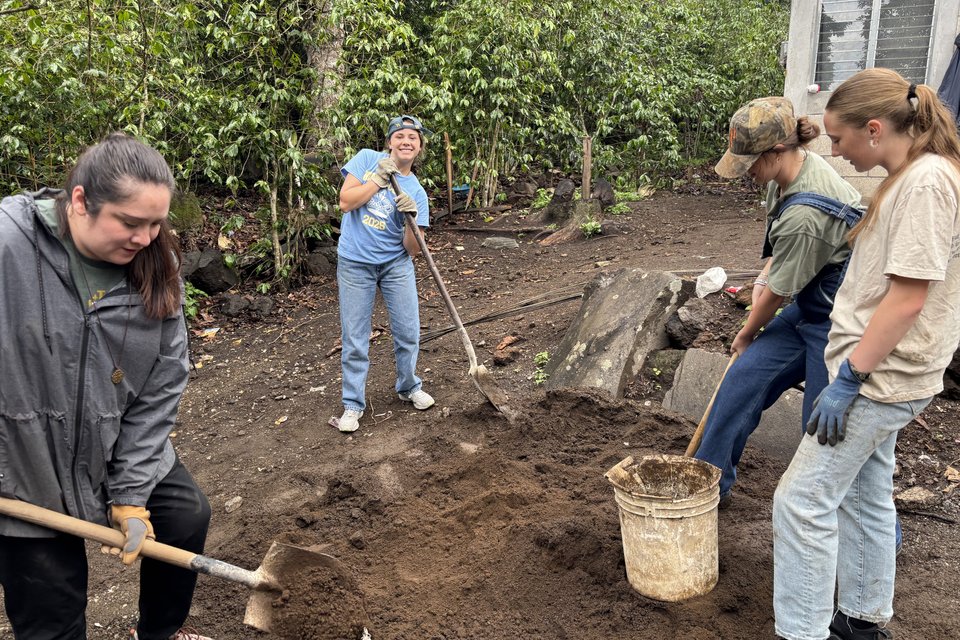From serving lepers in Africa to ministering in Manhattan on 9/11, Msgr. Moloney leaves global legacy; Fr. Ballien succeeds him
DEARBORN HEIGHTS — For six decades, Msgr. James Moloney has been known across the universal Church as “Moloney for the missions.”
The steadfast pastor of St. Anselm Parish in Dearborn Heights since 1979 was appointed associate director of the Society for the Propagation for the Faith and the Association of the Holy Childhood in 1961 for Detroit, and ever since then, raising money and awareness of the Church’s global mission of evangelization has been a cornerstone of Msgr. Moloney’s priesthood.
“Msgr. Moloney in a lot of ways inculcates the spirit of the foundress of the Society for the Propagation of Faith, Pauline Jaricot, somebody who gathered her family and friends in circles of 10 and prayed every day for the missions, sacrificing a sou, a penny, every week for the missions,” Monica Yehle-Glick, who worked with Msgr. Moloney for 35 years at the National Office of the Society for the Propagation of the Faith, told Detroit Catholic.
“Pauline Jaricot did that through a one-on-one approach, and that’s what Msgr. Moloney did. From Mission Sundays to collections throughout the year, Msgr. Moloney has the personal, human touch to get people to care for the missions,” Yehle-Glick said.
For the first time in six decades, someone other than Msgr. Moloney will lead Detroit's chapter of the Society for the Propagation of the Faith. On Aug. 1, Archbishop Allen H. Vigneron appointed Fr. Paul Ballien of St. John Neumann Parish in Canton as the society's director, succeeding Msgr. Moloney after 62 years.
Msgr. Moloney, 93, is recovering from a medical issue and couldn’t be interviewed by Detroit Catholic before publication.
The Society for the Propagation of the Faith raises money through a series of letter-writing campaigns to donors and World Mission Sunday, when pastors and priests from mission dioceses relay to the faithful the importance of supporting the Church’s global mission of spreading the Gospel of Jesus Christ.
Msgr. Moloney has been synonymous with the missions, Yehle-Glick said, joking that Msgr. Moloney has been director of the Society for the Propagation of the Faith in Detroit for as long as she’s been alive.
Yehle-Glick got her start with the society writing stories about the work the church missions were doing around the world, and Msgr. Moloney would instruct her to put in added geographical details about where the missions are located so the faithful could better understand where their money was going.
“I was 26 years old at the time, writing these stories about far-away places and the great work the Church was doing, and when I would write a town or some mission, I remember Msgr. Moloney saying to me, ‘If you are going to put something like that in, you’re going have to put in western Uganda, something practicable,’" Yehle-Glick said. “He wanted to help people understand where the mission was and connect with them in a way where people knew their history and situation.”
Yehle-Glick said Msgr. Moloney has a special talent for getting people to understand the history of the Society for the Propagation of the Faith — which supported the building up of the Church in United States until 1908, when the country ceased to be considered mission territory.
“Msgr. Moloney knows the essence of who were are is to be missionaries,” Yehle-Glick said. “He has great love for Pauline Jaricot and St. Therese of Lisieux, and every year for Mission Sunday, he’d write a homily for the priests of the diocese to use, pouring out his own love for the missions and desire to help them in a very concrete way.”
Msgr. Moloney visited 58 different countries to become more aware of the conditions of the missions, and he relayed those experiences back to the people of southeast Michigan so they could better understand the importance of the work.
But most of Msgr. Moloney’s time in the role was behind the scenes, writing letters to donors, organizing for Mission Sunday and building relationships with people who made the missions possible, Yehle-Glick said.

“I think because Msgr. Moloney focused on the individual stories of the people the missions were helping, the individuals and their needs, it began to resonate,” Yehle-Glick said. “There is something about the word catholic with a small ‘c’ — that was Pauline Jaricot’s vision and Msgr. Moloney’s vision as well. We live in a universal Church, and we are to look out for each other, putting everything together for the good of all.”
Fr. Ballien knows he has big shoes to fill. From 2007 to 2011, when Fr. Ballien was stationed at St. Ignatius Parish in the Cayman Islands — a mission parish under the pastoral stewardship of the Archdiocese of Detroit — even he benefitted from the society's patronage.
“Msgr. Moloney has done such a great job with the Society for the Propagation of the Faith,” Fr. Ballien said.
“I owe him a big debt of gratitude, because when I was in the Cayman Islands, one of the things we did when I was down there was raise money to build a church on Cayman Broc, Stella Maris," Fr. Ballien added. "The island didn’t have a Catholic church on it, and it was Msgr. Moloney who came through with a big donation from the Society for the Propagation of the Faith. Without that donation, we wouldn’t have been able to build that church.”
Yehle-Glick said Msgr. Moloney’s near-encyclopedic knowledge of the missions and the history of the Society for the Propagation of the Faith has made him a near-legend in Church circles across the world, including recognition from Cardinal Luis Tagle, pro-prefect for the Section of the First Evangelization and New Particular Churches of the Dicastery for Evangelization (formerly the Congregation for the Evangelization of Peoples). Under Msgr. Moloney's leadership, Detroit frequently raised more for the missions than any other American diocese.
From 1822 to 1922, the society donated the equivalent of $7 million from the Catholics of Europe to the United States when it was a mission territory.
Yehle-Glick recalls a particular time in the history of the society when there was a debate about “twinning,” in which funds raised from a diocese would go to a particular partner parish or diocesan mission, as opposed to going to a general fund that could be distributed based on need.
Msgr. Moloney wrote an article about his experience going to Uganda and seeing the situation on the ground, Yehle-Glick recalled, noting that for every mission he was able to name, there were three more that had no name.
Such “off the map” missions would be forgotten by the twinning model, Msgr. Moloney argued.
“(Without twinning), no one would be forgotten, no one would be left behind,” Yehle-Glick said. “The money would go to all the missions, and it’s a vision that lasts to this day. Msgr. Moloney is and has been the greatest advocate for the general fund, reminding us all to think about the places we don’t know about yet, but need our help.”

In addition to serving the Society for the Propagation of the Faith — becoming national secretary in 1975 and national vice president in 1983 — Msgr. Moloney has been pastor of St. Anselm since 1979, managing the parish and school, and never once giving the impression he was too busy for either.
“It was something he loved. I don’t want to say it was a hobby, but I’d see him sitting in his chair, reading his letters coming from missionaries, spending a lot of his own time working with the society,” said Gary Nosis, facilities and operations director at St. Anselm. “He never saw the society as something that took him away from his 9-5 job at St. Anselm. He was always here for the parish and always here for the missions.”
Msgr. Moloney regaled his colleagues at St. Anslem with tales from his missionary work, including once when he and Mother Theresa were chatting over dinner.
“Monsignor was sitting with Mother Teresa, and everyone was sitting around the table in awe, because they were chatting like they knew each other forever,” Nosis said. “He told her a story about when he went to a place to visit lepers. He assisted the sisters there by sewing (the lepers’) eyes shut from the flies. And Mother Teresa told him he was never closer to God than when he did that.”
Msgr. Moloney's frequent trips to the national society's offices in Manhattan for meetings usually didn't present opportunities for ministry, but they did on the fateful morning of Sept. 11, 2001. He landed at LaGuardia, but didn't make it to his meeting.
“Traffic was blocked each way, and the bridges were shut. You could only get out of Manhattan, couldn’t get in,” Yehle-Glick said. “So a taxi left him at the foot of the 59th Street Bridge."
Msgr. Moloney was walking over the bridge when one of the twin towers of the World Trade Center collapsed.
"Smoke and fire were everywhere. And there he was, wearing his collar — he was always wearing his collar, a symbol of his priesthood," Yehle-Glick said. "And he was there, praying with them on that bridge. None of us knew what was happening, but he became a missionary at that moment. A missionary is about bringing the transformative news of the Gospel of Jesus Christ, into a world that desperately needs it, and he was on that day for those people.”
Most of Msgr. Moloney’s stories aren’t as dramatic, but they are just as powerful, such as writing personal letters to each donor to the missions.
“He had this personal touch; everyone who sent $1, $5 or $10 got a personal letter from him, thanking them for their donation,” said Laura Gutierrez, administration assistant and business manager at St. Anselm. “That went a long way. He has so many faithful givers because he was so appreciative of the donors who gave. It was all about the personal touch with him.”
As Fr. Ballien assumes the mantle of leadership for the society, he recognizes he's standing on the shoulders of a giant.
The Church still has plenty of work to do to spread the Gospel of Jesus Christ around the world, Fr. Ballien added — work he hopes to tackle with the same passion as his predecessor.
“There are 8 billion people on the planet, and only 1-2 billion are Christian, so there is plenty of work to be done,” Fr. Ballien said. “There are still plenty of places in the world where people maybe have heard of Christ, but there is a lack of education or material needs. The Church can provide to help them know and love Christ.”
Copy Permalink
Missions














